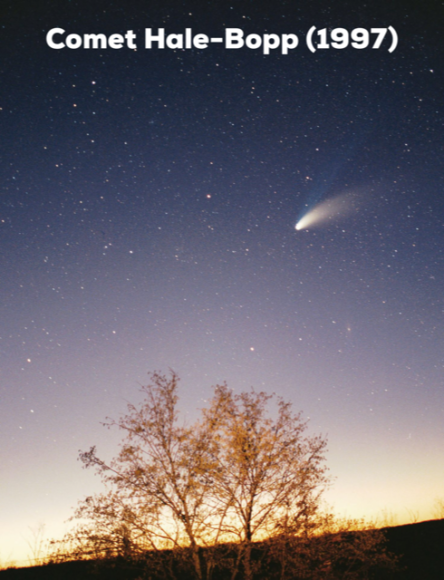 The last time we had a comet of any note here in the northern hemisphere was 1997’s Comet Hale-Bopp. I can recall standing in my driveway one April evening in the Capital View section of Little Rock and seeing it shining brightly in the northwest part of the sky. Ah, such sweet memories. So yeah, we are overdue for this kind of cosmic spectacle to once again grace our skies.
The last time we had a comet of any note here in the northern hemisphere was 1997’s Comet Hale-Bopp. I can recall standing in my driveway one April evening in the Capital View section of Little Rock and seeing it shining brightly in the northwest part of the sky. Ah, such sweet memories. So yeah, we are overdue for this kind of cosmic spectacle to once again grace our skies.
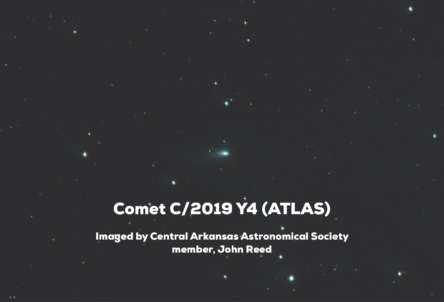 At the end of 2019, it looked like we might just be seeing a bright, naked eye comet here in the northern hemisphere with C/2019 Y4 (ATLAS), a comet discovered on 28 December 2019 by the Asteroid Terrestrial-impact Last Alert System (ATLAS), a robotic observatory funded by NASA that looks for near-Earth objects that could potentially collide with our planet. Shortly after its discovery, ATLAS began to show signs of being an overachiever by brightening at a very fast pace. Amateur astronomers across the northern hemisphere were soon spotting it with their backyard telescopes and cameras. The media was all abuzz with headlines about a spectacular, naked eye comet coming into view in May. I began to get email inquiries from the public as to when and where to see it. Many folks, already stir crazy from COVID lockdown, were getting excited about the possibility of a celestial spectacle. Alas, it was not to be.
At the end of 2019, it looked like we might just be seeing a bright, naked eye comet here in the northern hemisphere with C/2019 Y4 (ATLAS), a comet discovered on 28 December 2019 by the Asteroid Terrestrial-impact Last Alert System (ATLAS), a robotic observatory funded by NASA that looks for near-Earth objects that could potentially collide with our planet. Shortly after its discovery, ATLAS began to show signs of being an overachiever by brightening at a very fast pace. Amateur astronomers across the northern hemisphere were soon spotting it with their backyard telescopes and cameras. The media was all abuzz with headlines about a spectacular, naked eye comet coming into view in May. I began to get email inquiries from the public as to when and where to see it. Many folks, already stir crazy from COVID lockdown, were getting excited about the possibility of a celestial spectacle. Alas, it was not to be.
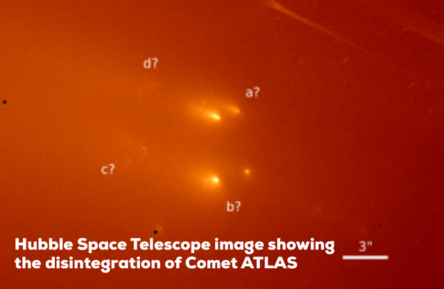 Famed comet hunter David H. Levy has said of comets: “Comets are like cats; they have tails and they both do precisely what they want.” By early April, ATLAS had ceased its brightening and was showing signs that the comet’s nucleus was breaking into pieces. Sure enough, on April 20, the Hubble Space Telescope confirmed our worst fears by showing that the nucleus had indeed broken into a number of fragments. It was definitely not going to be the comet of the century, as some had hoped. But then, from out of nowhere, a stranger rode into town.
Famed comet hunter David H. Levy has said of comets: “Comets are like cats; they have tails and they both do precisely what they want.” By early April, ATLAS had ceased its brightening and was showing signs that the comet’s nucleus was breaking into pieces. Sure enough, on April 20, the Hubble Space Telescope confirmed our worst fears by showing that the nucleus had indeed broken into a number of fragments. It was definitely not going to be the comet of the century, as some had hoped. But then, from out of nowhere, a stranger rode into town.
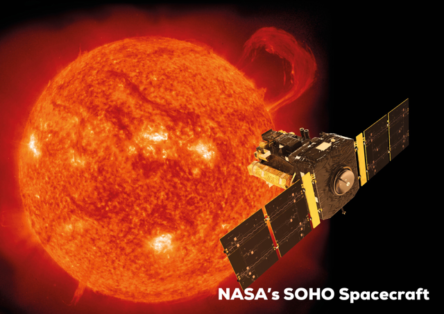 On April 11, the same day that ATLAS first began to show indications of breaking up, amateur astronomer Michael Mattiazzo found an entirely new comet while looking over data from NASA’s Solar and Heliospheric Observatory spacecraft, aka SOHO. Aboard SOHO is the Solar Wind ANisotropies (SWAN) camera, tasked with mapping out the distribution of hydrogen around the Sun in order to get a better handle on what our local star is up to. It’s not meant to be a comet hunter; however, by subtracting out the average hydrogen glow, and looking for bright points in ultraviolet light, it becomes possible to detect the presence of comets. Mattiazzo, a native of Australia, knows this and he is constantly poring over SWAN’s data looking for comets. He’s discovered eight since 2004. This newly discovered comet goes by the official name of C/2020 F8 SWAN. Will Comet SWAN become visible to the unaided eye? Wellllll, yes. Maybe? Remember David Levy’s admonition. Comets are fickle beasts so who knows what might happen. Plus, there are going to be some complicating factors which I will elaborate on in a moment.
On April 11, the same day that ATLAS first began to show indications of breaking up, amateur astronomer Michael Mattiazzo found an entirely new comet while looking over data from NASA’s Solar and Heliospheric Observatory spacecraft, aka SOHO. Aboard SOHO is the Solar Wind ANisotropies (SWAN) camera, tasked with mapping out the distribution of hydrogen around the Sun in order to get a better handle on what our local star is up to. It’s not meant to be a comet hunter; however, by subtracting out the average hydrogen glow, and looking for bright points in ultraviolet light, it becomes possible to detect the presence of comets. Mattiazzo, a native of Australia, knows this and he is constantly poring over SWAN’s data looking for comets. He’s discovered eight since 2004. This newly discovered comet goes by the official name of C/2020 F8 SWAN. Will Comet SWAN become visible to the unaided eye? Wellllll, yes. Maybe? Remember David Levy’s admonition. Comets are fickle beasts so who knows what might happen. Plus, there are going to be some complicating factors which I will elaborate on in a moment.
A COMET PRIMER
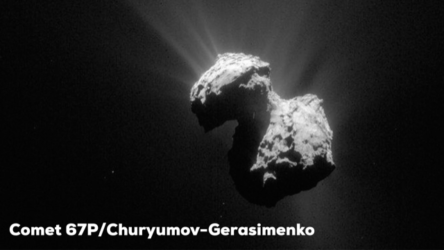 Comets are minor bodies within our solar system, being anywhere from a few football fields or a few miles in diameter. They are also quite old as they are relics from the solar nebula, the cloud of gas and dust that gave birth to the Sun, planets, moons, and asteroids that comprise the solar system some 4.6 billion years ago. Comets are loosely packed dirty snowballs, formed of various ices (i.e. water, carbon dioxide, methane, ammonia, carbon monoxide, and cyanide/cyanogen) as well as dirt and rocks. They also contain the primordial ingredients for life. Back in 2014, the European Space Agency’s Rosetta spacecraft reached Comet 67P/Churyumov-Gerasimenko and it put down the Philae lander onto the surface of the comet. It revealed that the comet is a stew of organic molecules, containing such things as proteins, carbohydrates, and nucleic acids; in essence, the building blocks of life. What’s more, these compounds comprised up to 50% of the dust that 67P is leaking into space. Such findings lend credence to the idea that comets may well have seeded the infant Earth with the ingredients for life. This “carbon soot” that coats a comet makes them very dark and difficult to see. That is, until they venture in closer to the Sun.
Comets are minor bodies within our solar system, being anywhere from a few football fields or a few miles in diameter. They are also quite old as they are relics from the solar nebula, the cloud of gas and dust that gave birth to the Sun, planets, moons, and asteroids that comprise the solar system some 4.6 billion years ago. Comets are loosely packed dirty snowballs, formed of various ices (i.e. water, carbon dioxide, methane, ammonia, carbon monoxide, and cyanide/cyanogen) as well as dirt and rocks. They also contain the primordial ingredients for life. Back in 2014, the European Space Agency’s Rosetta spacecraft reached Comet 67P/Churyumov-Gerasimenko and it put down the Philae lander onto the surface of the comet. It revealed that the comet is a stew of organic molecules, containing such things as proteins, carbohydrates, and nucleic acids; in essence, the building blocks of life. What’s more, these compounds comprised up to 50% of the dust that 67P is leaking into space. Such findings lend credence to the idea that comets may well have seeded the infant Earth with the ingredients for life. This “carbon soot” that coats a comet makes them very dark and difficult to see. That is, until they venture in closer to the Sun.
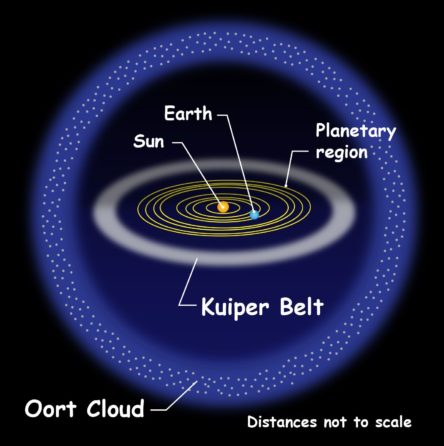 Some comets orbit the Sun out beyond the orbital path of Neptune in a region of the solar system known as the Kuiper Belt. But the main reservoir for comets is thought to be within an area known as the Oort Cloud, a vast shell of objects much further out than the orbit of Pluto that could contain billions, or even trillions, of comets. Pluto orbits some 30 AU to 50 AU from the Sun. An AU is an “astronomical unit”, the standard distance unit for the solar system. One AU is the equivalent of the Earth-Sun distance, roughly 93 million miles. The inner edge of the Oort cloud is thought to start at 2,000 AU or even 5,000 AU. Its outer edge could be as far away as 10,000 AU or even 100,000 AU. We just don’t know. Wherever they may originate from within the solar system, they are normally content to stay there, but every now and again, their orbits get perturbed and they are sent on a different path, one that might just send them heading towards the Sun. Once they get closer to the Sun, their ices begin to vaporize. Not melt, that would not be possible within the cold vacuum of space. Instead, the ices begin to undergo a process known as “sublimation”. Sublimation means that the ices go directly from being a solid to a gas. A comet undergoing sublimation starts to emit jets of gas from its surface. This material then forms a vast, glowing head around the nucleus (the main body of the comet) known as a “coma”. It’s when we see that coma that we usually first detect the presence of a comet. The coma may extend for thousands (or even tens of thousands) of miles and trailing behind it are tails of debris that can be millions of miles long. As the coma forms, it gets bombarded by UV light, which can then interact with compounds such as cyanogen and diatomic carbon. The atoms that make up these compounds will fluoresce when they become excited by the UV radiation, making the coma glow an eerie green color.
Some comets orbit the Sun out beyond the orbital path of Neptune in a region of the solar system known as the Kuiper Belt. But the main reservoir for comets is thought to be within an area known as the Oort Cloud, a vast shell of objects much further out than the orbit of Pluto that could contain billions, or even trillions, of comets. Pluto orbits some 30 AU to 50 AU from the Sun. An AU is an “astronomical unit”, the standard distance unit for the solar system. One AU is the equivalent of the Earth-Sun distance, roughly 93 million miles. The inner edge of the Oort cloud is thought to start at 2,000 AU or even 5,000 AU. Its outer edge could be as far away as 10,000 AU or even 100,000 AU. We just don’t know. Wherever they may originate from within the solar system, they are normally content to stay there, but every now and again, their orbits get perturbed and they are sent on a different path, one that might just send them heading towards the Sun. Once they get closer to the Sun, their ices begin to vaporize. Not melt, that would not be possible within the cold vacuum of space. Instead, the ices begin to undergo a process known as “sublimation”. Sublimation means that the ices go directly from being a solid to a gas. A comet undergoing sublimation starts to emit jets of gas from its surface. This material then forms a vast, glowing head around the nucleus (the main body of the comet) known as a “coma”. It’s when we see that coma that we usually first detect the presence of a comet. The coma may extend for thousands (or even tens of thousands) of miles and trailing behind it are tails of debris that can be millions of miles long. As the coma forms, it gets bombarded by UV light, which can then interact with compounds such as cyanogen and diatomic carbon. The atoms that make up these compounds will fluoresce when they become excited by the UV radiation, making the coma glow an eerie green color.
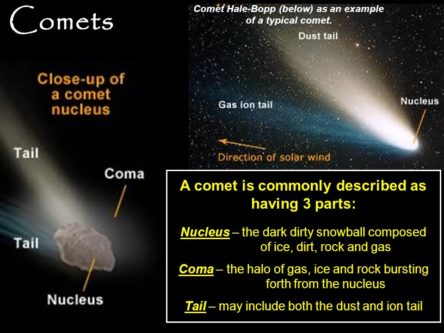 There are two types of tail associated with comets: the “ion tail”, a stream of glowing, ionized gas, usually a blue color and the “dust tail”, a yellowish trail of debris that curves out from under the nucleus of the comet. Both tails interact with the solar wind, a stream of charged particles that the Sun is continuously spewing out in all directions and extends far into the outer reaches of the solar system. As the comet heads towards the Sun, the solar wind pushes the tails behind the direction of travel, but as they head away from the Sun, the wind makes the tails appear to lead in the direction of travel. As I said earlier, a trail of debris from a comet tail can stretch for millions of miles and can persist for thousands of years. If the Earth’s orbit intersects one of these trails, we get a meteor shower whenever the planet plows through it every year. The debris is often no bigger than a grain of rice, but whenever it burns up in our atmosphere, it makes that glowing, brief streak of light in the sky that we call a meteor.
There are two types of tail associated with comets: the “ion tail”, a stream of glowing, ionized gas, usually a blue color and the “dust tail”, a yellowish trail of debris that curves out from under the nucleus of the comet. Both tails interact with the solar wind, a stream of charged particles that the Sun is continuously spewing out in all directions and extends far into the outer reaches of the solar system. As the comet heads towards the Sun, the solar wind pushes the tails behind the direction of travel, but as they head away from the Sun, the wind makes the tails appear to lead in the direction of travel. As I said earlier, a trail of debris from a comet tail can stretch for millions of miles and can persist for thousands of years. If the Earth’s orbit intersects one of these trails, we get a meteor shower whenever the planet plows through it every year. The debris is often no bigger than a grain of rice, but whenever it burns up in our atmosphere, it makes that glowing, brief streak of light in the sky that we call a meteor.
When comets hang out in their natural habitats, be it the Kuiper Belt or the Oort Cloud, their orbits around the Sun are more circular in shape, but once they deviate from those orbits and head towards the Sun, the orbital shape becomes more elongated into an ellipse (in astronomer speak, the orbits become much more “eccentric”). 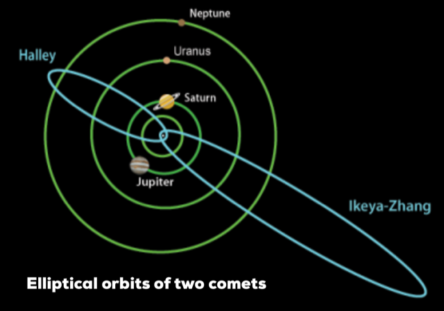 Sometimes, a comet will come in and plunge directly into the Sun, others, like ATLAS, might even break up before they ever even get there. Others still, are placed in orbits that will carry them around the Sun with a certain periodicity. Comets that pass through the solar system every 200 years or less are known as “short period comets” while those that take longer, some being on orbits that might take them thousands of years to complete one trip around the Sun, are aptly referred to as “long period comets”. Then there are comets who, either through gravitational interactions with the Sun, or with planets like Jupiter, get hurled out of the solar system altogether, never to return. These vagrants will roam all alone in space for eons before they might encounter another solar system. We have recently had two such alien visitors into our solar system: Oumuamua was an interstellar visitor that passed through the solar system in 2017 while the other, Comet 2I/Borisov came through the inner solar system in October of 2019.
Sometimes, a comet will come in and plunge directly into the Sun, others, like ATLAS, might even break up before they ever even get there. Others still, are placed in orbits that will carry them around the Sun with a certain periodicity. Comets that pass through the solar system every 200 years or less are known as “short period comets” while those that take longer, some being on orbits that might take them thousands of years to complete one trip around the Sun, are aptly referred to as “long period comets”. Then there are comets who, either through gravitational interactions with the Sun, or with planets like Jupiter, get hurled out of the solar system altogether, never to return. These vagrants will roam all alone in space for eons before they might encounter another solar system. We have recently had two such alien visitors into our solar system: Oumuamua was an interstellar visitor that passed through the solar system in 2017 while the other, Comet 2I/Borisov came through the inner solar system in October of 2019.
WHEN AND WHERE TO LOOK FOR COMET SWAN
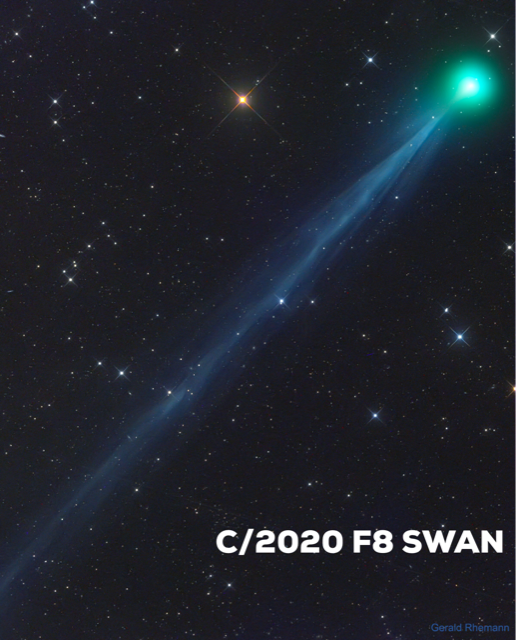 As I sit here writing these words during the last week of April, SWAN is already sporting an impressive tail and the nucleus is brightening up nicely. However, due to its location in space, it is currently only visible to folks in the southern hemisphere, we are going to have to wait a bit to see it and, here’s the rub: it’s only going to be a morning object and even then, it’s going to be very low in the sky, so it could be a challenge to observe (depending on just how well it performs). Right now, SWAN is headed towards the northeast but come May 6, those of us here in the northern hemisphere should get our earliest peek at it (be warned: it’s going to be very, very low in the eastern sky). Here are some dates to mark on your calendar.
As I sit here writing these words during the last week of April, SWAN is already sporting an impressive tail and the nucleus is brightening up nicely. However, due to its location in space, it is currently only visible to folks in the southern hemisphere, we are going to have to wait a bit to see it and, here’s the rub: it’s only going to be a morning object and even then, it’s going to be very low in the sky, so it could be a challenge to observe (depending on just how well it performs). Right now, SWAN is headed towards the northeast but come May 6, those of us here in the northern hemisphere should get our earliest peek at it (be warned: it’s going to be very, very low in the eastern sky). Here are some dates to mark on your calendar.
MAY 6 SWAN is in the constellation of Cetus the Whale, low in the eastern sky, about an hour before sunrise. You will definitely need binoculars and an observing location that offers a view clear down to the horizon. Good luck, you will need it.
MAY 7 SWAN is heading northward all this month and on this day, it will cross the celestial equator as it does so.
MAY 9 SWAN now crosses the ecliptic, the imaginary line upon the sky that traces the path of the Sun, moon, and planets throughout the course of a year.
MAY 12 SWAN passes within two degrees of the +3.4 magnitude star Eta Piscium (in Pices) and the galaxy Messier 74. If you are an experienced astrophotographer, this will make for a stunning photo opportunity.
MAY 13 SWAN is at its closest distance to the Earth at 51.7 million miles away.
MAY 15 Between the 15th and the 23rd, SWAN is predicted to reach its peak magnitude of 3.5, certainly bright enough to be seen with the unaided eye. BUT, the comet is still low in the northeastern sky during the hours before dawn. You are still going to need binoculars to spot it.
MAY 16 SWAN passes within just six degrees of galaxy Messier 33. Another potential photo op.
MAY 18 SWAN is now crossing over into the constellation of Perseus.
MAY 19 SWAN passes by +4.2 magnitude star 16 Persei.
MAY 19 SWAN passes within 14 arcseconds of +2 magnitude star Algol. This will be an opportunity to easily find the comet as Algol is an easily located star and both comet and star will be within the same FOV with binoculars or a small telescope.
MAY 22 SWAN passes by the remains (if any) of Comet ATLAS.
MAY 26 SWAN is now at its furthest point northwards upon our sky. It’s all downhill from here.
MAY 27 SWAN is at perihelion, its closest distance from the Sun at 39.9 million miles.
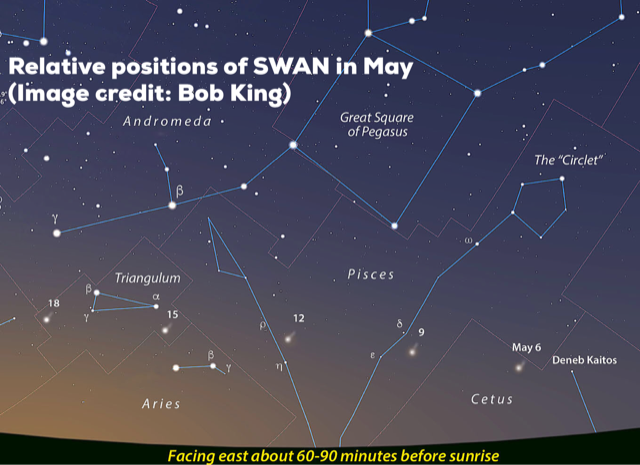
Comet SWAN, even if it follows predictions, will likely be a challenge to spot in our skies, but that’s okay with me, I like a challenge and I love comets so, yeah, I’m excited about getting up early, going outside and looking up in both awe and wonder.